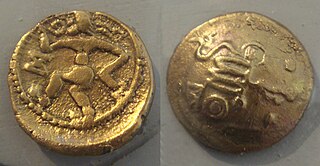Related Research Articles
The Reii were a Celto-Ligurian tribe dwelling in the modern department of Alpes-de-Haute-Provence during the Iron Age and the Roman period.

The Petrocorii were a Gallic tribe dwelling in the present-day Périgord region, between the Dordogne and Vézère rivers, during the Iron Age and the Roman period.
The Medulli were a Gallic tribe dwelling in the upper valley of Maurienne, around present-day Modane (Savoie), during the Iron Age and Roman period.

The Parisii were a Gallic tribe that dwelt on the banks of the river Seine during the Iron Age and the Roman era. They lived on lands now occupied by the modern city of Paris, whose name is derived from the ethnonym.

The Ambarri were a Gallic people dwelling in the modern Ain department during the Iron Age and the Roman period.
The Seduni were a Gallic tribe dwelling in the upper Rhône valley, around present-day Sion, during the Iron Age and the Roman period.
The Ceutrones were a Gallic tribe dwelling in the Tarantaise Valley, in modern Savoie, during the Iron Age and Roman period.
The Caturiges were a Gallic tribe dwelling in the upper Durance valley, around present-day towns of Chorges and Embrun, during the Iron Age and the Roman period.

The Gabali were a Gallic tribe dwelling in the later Gévaudan region during the Iron Age and the Roman period.

The Namnetes were a Gallic tribe dwelling near the modern city of Nantes during the Iron Age and the Roman period.
The Helvii were a relatively small Celtic polity west of the Rhône river on the northern border of Gallia Narbonensis. Their territory was roughly equivalent to the Vivarais, in the modern French department of Ardèche. Alba Helviorum was their capital, possibly the Alba Augusta mentioned by Ptolemy, and usually identified with modern-day Alba-la-Romaine. In the 5th century the capital seems to have been moved to Viviers.

The Segusiavī were a Gallic tribe dwelling around the modern city of Feurs (Auvergne-Rhône-Alpes) during the Iron Age and the Roman period.
The Adanates or Edenates were a small Gallic tribe dwelling around present-day Seyne, in the Alpes Cottiae, during the Iron Age.
The Suetrii or Suetri were a Gallic tribe dwelling around present-day Castellane (Alpes-de-Haute-Provence) during the Iron Age and the Roman period.
The Belaci were a small Gallic tribe dwelling in the Alpes Cottiae, around present-day Oulx, during the Iron Age.
The Bodiontici or Brodiontii were a Gallic tribe dwelling around present-day Digne (Alpes-de-Haute-Provence) during the Roman period.
The Ecdinii or Ecdini were a Gallic tribe dwelling in the valley of the Tinée (Alpes-Maritimes) during the Iron Age.
The Quariates or Quadiates were a Gallic tribe dwelling in the valley of Queyras, in the Alps, during the Iron Age.
The Sogionti or Sogiontii were a Gallic tribe dwelling around present-day Sisteron during the Iron Age.
The Brigianii were a Gallic tribe dwelling around present-day Briançon during the Iron Age and the Roman period.
References
- ↑ Caesar. Commentarii de Bello Gallico, 1:10:4.
- 1 2 Falileyev 2010, s.v. Graioceli.
- ↑ Delamarre 2019, p. 370.
- ↑ Talbert 2000, Map 17: Lugdunum.
- ↑ Barruol 1969, p. 43.
- ↑ Rivet 1988, p. 335.
Primary sources
- Caesar (1917). The Gallic War. Loeb Classical Library. Translated by Edwards, H. J. Harvard University Press. ISBN 978-0-674-99080-7.
Bibliography
- Barruol, Guy (1969). Les Peuples préromains du Sud-Est de la Gaule: étude de géographie historique. E. de Boccard. OCLC 3279201.
- Delamarre, Xavier (2019). Dictionnaire des thèmes nominaux du gaulois. Ab-/Iχs(o)-. Vol. 1. Les Cents Chemins. ISBN 978-1-7980-5040-8.
- Falileyev, Alexander (2010). Dictionary of Continental Celtic Place-names: A Celtic Companion to the Barrington Atlas of the Greek and Roman World. CMCS. ISBN 978-0955718236.
- Rivet, A. L. F. (1988). Gallia Narbonensis: With a Chapter on Alpes Maritimae : Southern France in Roman Times. Batsford. ISBN 978-0-7134-5860-2.
- Talbert, Richard J. A. (2000). Barrington Atlas of the Greek and Roman World. Princeton University Press. ISBN 978-0691031699.
